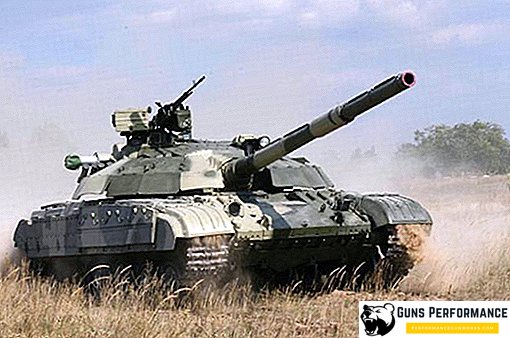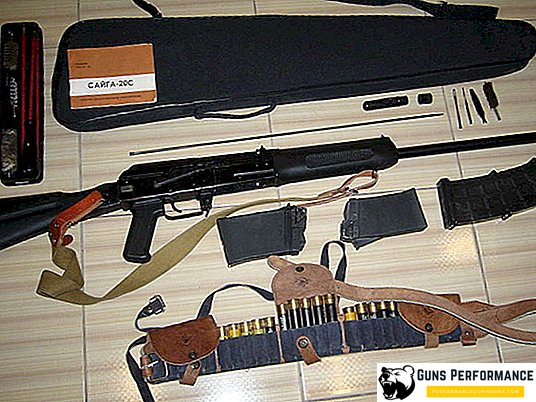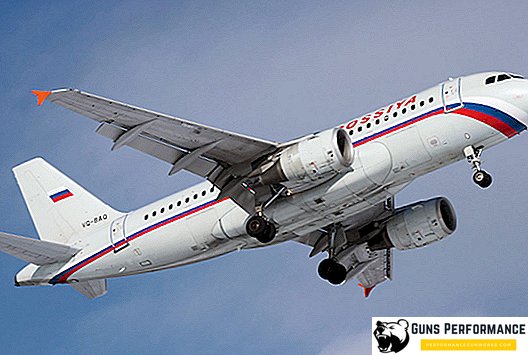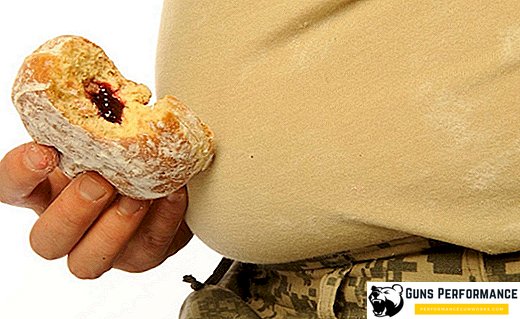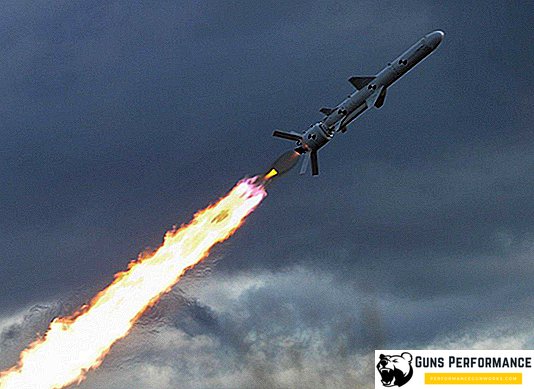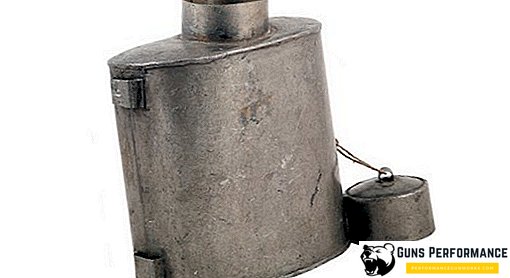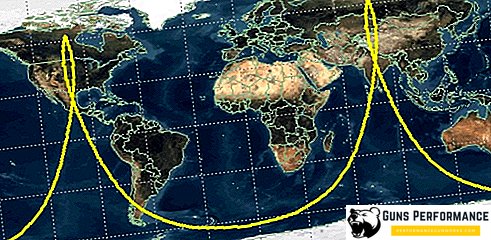The Boeing 707 is a four-engine narrow-body passenger airliner, as well as one of the first jet passenger aircraft in the world.
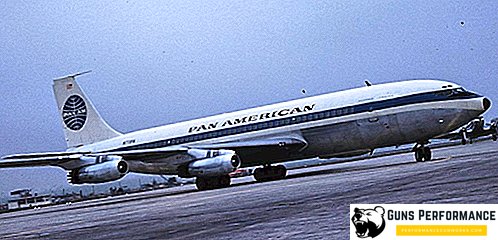
Aircraft Overview
From the aerodynamic point of view, the Boeing 707 is a four-engine low-wing aircraft. The wing of the liner is swept, the plumage is single-chin.
The passenger cabin of the Boeing 707 usually has 2 classes (business and economy) or 1 class (only economy). Since the plane is a narrow-body aircraft, this means that the business-class seats are located, as a rule, according to the “2-2” scheme, and the economy-class - according to the “3-3” scheme. Thus, depending on the aircraft modification or on the layout variant of the passenger cabin, the Boeing 707 could accommodate from 110 to 202 passengers.
The Boeing 707 powerplant is represented by Pratt & Whitney JT3C-1, JT3D-3 or JT3D-7 turbojets.

History of creation and use
During World War II and the second half of the 1940s, Boeing specialized in developing strategic bombers (the company's planes were designated B: B-17, B-25, etc.) After the war, the company faced an urgent need to redefine the development of aircraft due to the reduced demand for military aircraft, as well as due to the great prospects that could open in the 50s passenger aircraft industry.
As a result, in the early 1950s, work began on the creation of a jet passenger liner, which has common features similar to the B-47 Stratojet strategic bomber. A new aircraft was being developed under the strictest secrecy, and therefore, few people knew that its designation was exactly Boeing 707. The name then was “367-80”.
During the development of the liner, the creators used a number of non-standard and new solutions at that time. So, one of them was the fact that the aircraft engines were installed in separate special nacelles, which ensured their reliability and at the same time security: when one engine ignited, the chances of fire spread to the other were practically zero. Another innovation was the installation of aircraft engines directly under the wing, which ensured the high aerodynamic properties of the aircraft in general.
In the summer of 1954, the aircraft 367-80 made the first flight. However, the process of testing the liner, the creation of its new (in particular, military) modifications somewhat delayed the beginning of the commercial use of the Boeing 707. As a result, the mass production and operation of the aircraft began in 1958.
Initially, the main exploiters of the aircraft were two US airlines: Trans World Airlines and PanAmerican. They seriously increased the fleet of their aircraft, which led to a rapid growth in demand for passenger traffic not only in the United States, but throughout the world.
The 60s of the 20th century were truly an hour of triumph for the Boeing 707 airliner. The aircraft's popularity grew, and soon began to be ordered by Western European airlines. However, it is worth noting that the penetration of the Boeing 707 into the European market was complicated by the fact that McDonnell Douglas DC-8 aircraft confidently held their position here. This advantage was mainly due to the company's best reputation over Boeing, which specialized for a long time exclusively on military aircraft. However, then, after a number of improvements and the release of modifications (in particular, 320B), the Boeing 707 began to confidently win the lead.

The end of the 60s - the beginning of the 70s is characterized by a high demand for passenger air travel, in connection with which the popularity of the aircraft, and with it the number of orders for it, began to fall. Also, a contribution was made by the development of a new long-haul aircraft - the Boeing 747, which had greater passenger capacity and the potential to create modifications, albeit with a slightly higher fuel consumption. All this led to the fact that in 1978 the last serial Boeing 707 was released.
In just 20 years of production, 1010 Boeing 707 airliners were built, of which 194 were lost. Thus, out of the total number of aircraft, approximately one in five was lost. This is mainly due to the technical imperfection of the liner, characteristic of the machines of the time, as well as the crew’s mistakes.
To date, about a hundred aircraft are still in operation, but mostly they are cargo modifications of the Boeing 707.
Liner modifications
Boeing 707 is represented by a variety of modifications, both passenger and cargo. We should also take into account the military model of the Boeing 707, designed for the needs of the US Air Force.
- The Boeing 707-120 is a basic modification of the aircraft, with good (for those times) passenger capacity (from 110 to 179 people) and speeds of up to 965 km / h.
- Boeing 707-220 - modification of the Boeing 707 with more powerful engines and, as a result, with a slightly increased fuel consumption. Total produced 5 aircraft of this model. There is also a modification of the Boeing 707-220B.
- Boeing 707-227 - modification with increased passenger capacity.
- Boeing 707-320B - the second major modification of the Boeing 707, with its increased size, greater passenger capacity and equipped with more powerful engines. Also for this modification were developed versions of the Boeing 707-320 Intercontinental (with increased flight range), Boeing 707-320B Advanced and Boeing 707-320C.
- Boeing 707-420 is a modification of the Boeing 707 liner, equipped with Rolls-Royce engines.
- Boeing 707-700 - modification of the aircraft with an elongated body and increased passenger capacity, as well as longer range.
- VC-137C - a version of the liner, created in two copies and designed to transport US senior management.
Military modifications of the Boeing 707 were created mainly on the basis of the model 707-320:
- E-3 Sentry - long-range radar detection aircraft.
- E-6 Mercury - air command and control and communications.
- E-8 JSTARS - the aircraft for conducting ground-based radar reconnaissance.
- C-18 - military transport modification of the Boeing 707.
- EC-18B - laboratory aircraft designed for testing anti-aircraft and ballistic missiles.

Boeing 707 Specifications
Flight performance of the main passenger modifications of the Boeing 707:
| Boeing 707-120B | Boeing 707-320B | |
| Dimensions | ||
| Length m | 44 | 46,6 |
| Wingspan, m | 39,9 | 44,4 |
| Height, m | 12,7 | 12,7 |
| Wing area, sq. M | 226 | 268,7 |
| Weight | ||
| Max. take-off weight, kg | 116 700 | 151 300 |
| Max. landing weight, kg | 86 200 | 112 000 |
| Empty weight, kg | 58 700 | 65 400 |
| Max. mass without fuel, kg | 77 100 | 88 500 |
| Max. payload, kg | 19 300 | 23 400 |
| Max. fuel capacity, kg | 65 700 | 90 290 |
| Flight data | ||
| Flight range with max. loading, km | 6 700 | 9 200 |
| Max. cruising speed, km / h | 965 | 965 |
| Engines | P & W JT3D-1, | P & W JT3D-3, |
| 4 x 7700 kgf | 4 x 8170 kgf | |
| P & W JT3D-7, | ||
| 4 x 8600 kgf | ||
| Passenger salon | ||
| Number of seats (single class layout) | 174 | 189 |
| Number of seats (two-class layout) | 137 | 141 |
| Cabin length, m | 31,9 | 33,9 |
| Interior width, m | 3,6 | 3,6 |
| Cabin height, m | 2,4 | 2,4 |

Conclusion
The Boeing 707 was created at the right time for its time - at a time when the demand for aviation passenger transportation began to grow at a rapid pace. This allowed the aircraft to become very popular in the 1960s. However, the emergence of new models of passenger liners, as well as the technical imperfection of the Boeing 707, after 10 years, pushed it into the background. Nevertheless, thanks to a number of interesting innovative design solutions used in its development, the Boeing 707 has taken a worthy place in the history of aviation and air travel.


